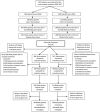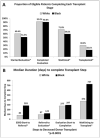The role of race and poverty on steps to kidney transplantation in the Southeastern United States
- PMID: 22233181
- PMCID: PMC3950902
- DOI: 10.1111/j.1600-6143.2011.03927.x
The role of race and poverty on steps to kidney transplantation in the Southeastern United States
Abstract
Racial disparities in access to renal transplantation exist, but the effects of race and socioeconomic status (SES) on early steps of renal transplantation have not been well explored. Adult patients referred for renal transplant evaluation at a single transplant center in the Southeastern United States from 2005 to 2007, followed through May 2010, were examined. Demographic and clinical data were obtained from patient's medical records and then linked with United States Renal Data System and American Community Survey Census data. Cox models examined the effect of race on referral, evaluation, waitlisting and organ receipt. Of 2291 patients, 64.9% were black, the mean age was 49.4 years and 33.6% lived in poor neighborhoods. Racial disparities were observed in access to referral, transplant evaluation, waitlisting and organ receipt. SES explained almost one-third of the lower rate of transplant among black versus white patients, but even after adjustment for demographic, clinical and SES factors, blacks had a 59% lower rate of transplant than whites (hazard ratio = 0.41; 95% confidence interval: 0.28-0.58). Results suggest that improving access to healthcare may reduce some, but not all, of the racial disparities in access to kidney transplantation.
© 2011 The American Society of Transplantation and the American Society of Transplant Surgeons.
Conflict of interest statement
Figures


Comment in
-
Transplantation: role of race and socioeconomic status in transplant access.Nat Rev Nephrol. 2012 Jan 31;8(3):130. doi: 10.1038/nrneph.2012.6. Nat Rev Nephrol. 2012. PMID: 22290544 No abstract available.
References
-
- Powe NR. To have and have not: Health and health care disparities in chronic kidney disease. Kidney Int. 2003;64:763–772. - PubMed
-
- Hall YN, O'Hare AM, Young BA, Boyko EJ, Chertow GM. Neighborhood poverty and kidney transplantation among US Asians and Pacific Islanders with end-stage renal disease. Am J Transplant. 2008;8:2402–2409. - PubMed
Publication types
MeSH terms
Grants and funding
LinkOut - more resources
Full Text Sources
Medical

